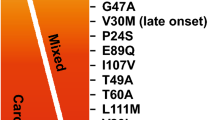Abstract
Plasma adrenaline and noradrenaline levels were measured while supine and following head-up tilt to 45°, in both normal controls and in patients with familial amyloidotic polyneuropathy of the Portuguese type. In nine patients systolic blood pressure fell by less than 15mmHg, while in seven patients it fell by more than 15mmHg. Plasma noradrenaline rose during tilt in the majority of patients, as in the controls. There was no correlation between levels of catecholamines and fall in blood pressure on head-up tilt. The data excludes widespread sympatho-neural failure as a cause for postural hypotension in familial amyloidotic polyneuropathy of the Portuguese type. The results are compatible with either segmental/patchy sympathetic denervation or dysfunction of the receptor/effector mechanisms in target organs such as the heart and blood vessels.
Similar content being viewed by others
References
Andrade C. A peculiar form of peripheral neuropathy.Brain 1952;75: 408–427.
Glenner GG, Ignaczak TF, Page DL. The inherited systemic amyloidosis and Iocalized amyloid deposits. In: Stanbury JB, Wyngaarden JB, Fredrickson DS, eds.The metabolic basis of inherited diseases. Fourth edition. New York: McGraw-Hill, 1978: 1309–1339.
Saraiva MJM, Costa PP, Birken S, Goodman DS. Presence of an abnormal transthyretin (prealbumin) in Portuguese patients with familial amyloidotic polyneuropathy.Trans Assoc Am Phys 1983;96: 261–270.
Saraiva MJ, Costa PP, Goodman DS. Biochemical marker in familial amyloidotic polyneuropathy, Portuguese type.J Clin Invest 1985;76: 2171–2177.
Wallace MR, Naylor SLG, Kluve-Beckrman B, Long GL, McDonald L, Slows TB, Benson MD. Localization of the human prealbumin gene to chromosome 18.Biochem Biophys Res Commun 1985;129: 753–756.
Ducla-Soares J, Alves M, Salles-Luis ML, Povoa P, Ferreira M, Serrao R, Palma-Carlos AG. Autonomic function in familial amyloidotic polyneuropathy patients and relatives. Proceedings of the First International Symposium on Familial Amyloidotic Polyneuropathy and Other Transthyretin-Related Disorders, Granja-Portugal, 1988.Arquivos de Medicina 1990;3: 271–4.
Ewing DJ, Clarke BF. Diagnosis and management of diabetic autonomic neuropathy.Br Med J 1982;285: 916–918.
Ewing DJ, Martyn CN, Clarke BF. The value of cardiovascular autonomic function tests: 10 years experience in diabetes.Diabetes Care 1985;8: 491–498.
Foti A, Kimura S, DeQuattro V, Lee D. Liquid-chromatographic measurement of catecholamines and metabolites in plasma and urine.Clin Chem 1987;33: 2209–2213.
Sales-Luis ML, Galvao M, Carvalho M, Sousa G, Alves MM, Serrao R. Plasma exchange (PE) on the treatment of familial amyloidotic polyneuropathy (FAP) Portuguese type.Arquivos de Medicina 1990;3: 361–70.
Carvaho J, Coimbra A, Andrade C. Peripheral nerve changes in asymptomatic children of patients with familial amyloid polyneuropathy.Brain 1976;99: 1–10.
Coimbra A, Andrade C. Familial amyloid polyneuropathy: an electron microscope study of the peripheral nerve in five cases. I. Intersticial changes.Brain 1971;94: 199–206.
Coimbra A, Andrade C. Familial amyloid polyneuropathy: an electron microscope study of the peripheral nerve in five cases. II. Nerve fiber changes.Brain 1971;94: 207–212.
Dyck PJ, Lambert SH. Dissociated sensation in amyloidosis.Arch Neurol 1969;20: 490–496.
Ducla-Soares J, Alves M, Sales-Luis ML, Povoa P, Ferreira M, Serrao R, Palma-Carlos AG. Autonomic function in familial amyloidotic polyneuropathy patients and relatives. Identification of autonomic dysfunction as the first neurological involvement. Proceedings of the VII Meeting of the Clinical Autonomic Research Society, London 1989.J Autonomic Nervous System, in press.
Suzuki T, Tsuge I, Higa S, Hayashi A, Yamamura Y, Takaba Y, Nakajima A. Catecholamine metabolism in familial amyloid polyneuropathy.Clin Genet 1979;16: 117–24.
Freitas AF, Azevedo S, Maciel L. Defective cardiovascular autonomic responses in familial amyloidotic polyneuropathy, In: Glenner GG, Costa PP, Freitas AF, eds.Amyloid and amyloidosis. Proceedings of the Third International Symposium on Amyloidosis. Povoa de Varzim, Portugal, 23–28 September 1979. Amsterdam: Excerpta Medica, 1980: 106–112.
Christensen NJ. Plasma catecholamines in long-term diabetics with and without neueropathy and in hypophysectomized subjects.J Clin Invest 1972;51: 779–798.
Cryer PE, Silverberg AB, Santiago JV, Shah SD. Plasma catecholamines in diabetes. The syndromes of hypoadrenergic and hyperadrenergic postural hypotension.Am J Med 1978;64: 407–416.
Christlieb AR, Janka H-U, Kraus Bet al. Vascular reactivity to angiotensin II and to norepinephrine in diabetic subjects.Diabetes 1976;25: 268–274.
Polinsky RJ, Kopin IJ, Ebert MH, Weise V. Pharmacologic distinction of different orthostatic hypotension syndromes.Neurology 1981;31: 1–722.
Streeten DHP. Pathogenesis of hyperadrenergic orthostatic hypotension.J Clin Invest 1990;86: 1582–8.
Hoeldtke RD, Dworkin GE, Gaspar SR, Israel BC. Sympathotonic orthostatic hypotension: a report of four cases.Neurology 1989;39: 34–40.
Oppenheimer JH. Plasma proteins in distribution and metabolism of thyroid hormones.N Engl J Med 1968;278: 1153–62.
Refetoff S, Dwulet FE, Benson MD. Reduced affinity for thyroxine in two of three structural variants associated with familial amyloidotic polyneuropathy.J Clin Endocrinol Metab 1986;63: 1432–7.
Lefkowitz RL, Caron MG, Stiles G. Mechanisms of membranereceptor regulation. Biochemical, physiological, and clinical insights derived from studies of the adrenergic receptors.N Engl J Med 1984;310: 1570–9.
Author information
Authors and Affiliations
Rights and permissions
About this article
Cite this article
Ducla-Soares, J., Breitenfeld, L., Póvoa, P. et al. Plasma catecholamines and postural hypotension in familial amyloidotic polyneuropathy of the Portuguese type. Clinical Autonomic Research 1, 271–274 (1991). https://doi.org/10.1007/BF01819831
Received:
Accepted:
Issue Date:
DOI: https://doi.org/10.1007/BF01819831




